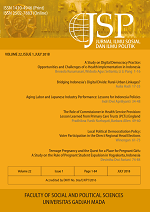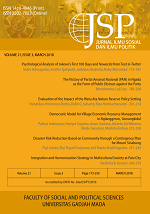Local Political Democratization Policy: Voter Participation in the Direct Regional Head Elections
Winengan Winengan(1*)
(1) Universitas Islam Negeri Mataram
(*) Corresponding Author
Abstract
The regional head election, a local political event and a symbol of democratic government, is a contest for a legitimized power of regional leaders, who are given authority and responsibility to administer and lead the regional apparatus and development. Since the Indonesian reformation era, the policy regarding the regional head election has shifted from being elected by the local legislative assembly (representative system) to being elected by the people directly (direct election). Anchored in the quantitative descriptive research design, in which the data was garnered from documentation, this study aims to examine the extent to which the people partook in the first round of the direct and simultaneous regional head election in 2015. The collected data was analyzed by means of the participatory and democracy approach within the local political landscape. The empirical findings showed that the public participation in the local election remained low given the statistical evidence (64.02% of the total voters). The study demonstrates that despite the provision of the political stage within the local scope, it does not fully encourage the people to exercise their political rights.
Keywords
Full Text:
PDFReferences
Agus. (2016). Pemetaan sosiologis perilaku memilih di Nusa Tenggara Barat. Jurnal Transformative, 2(1), 1-15.
Akbar, M. (2015, Desember 11). Lembaga survei: partisipasi pemilih dalam pilkada serentak rendah. Republika.co.id. Retrieved from https://www.republika.co.id/berita/ nasional/pilkada/15/12/11/nz74qx336- lembaga-survei-partisipasi-pemilih-dalam- pilkada-serentak-rendah
Arianto, B. (2011). Analisis peny ebab masyarakat tidak memilih dalam pemilu. Jurnal Ilmu Politik dan Ilmu Pemerintahan, 1(1), 51-60.
Arwiyah, M. Y. (2012). Status sosial ekonomi dan kualitas partai politik dalam meningkatkan partisipasi politik. Jurnal Mimbar, 28(1), 85-92.
Aspinall, E. (2010). The irony of success. Journal of Democracy, 21(2), 20-34.
Budiardjo, M. (1981). Partisipasi dan partai politik. Jakarta: Gramedia Pustaka Utama.
Budiman, H. (2015). Pilkada tidak langsung dan demokrasi palsu. Yogyakarta: Pustaka Yustisia.
Curvale, C. (2013). Citizen participation, social trust, and ethneic grouf in Ecuador. Asian Journal of Latin American Studies, 26(1), 75-96.
Dahl, R. (1998). Democracy. USA: Yale University Press.
Ambardi, D. (2015, December 11). Di balik partisipasi Pilkad a 2015 ‘yang menurun’. BBC. Retriev ed from http://www.bbc.com/indonesia/berita_ indonesia/2015/12/151210_indonesia_ pilkada
Fachrudin, A. (2015, Desember 14). Menyoal partisipasi pemilih pilkada. Retrieved from http://www.bawaslu-dki.go.id.
Fenyapwain, M. M. (2013). Pengaruh iklan politik dalam pilkada Minahasa terhadap partisipasi pemilih pemula di Desa Tounelet Kecamatan Kakas. Jurnal Acta Diurna, 1(1), 1-16.
Gaffar, A. (1992). Pembangunan hukum dan demokrasi. Yogyakarta: UII Press.
Hadiz, V. R. (2004). Decentralization and democracy in Indonesia: a critique of neo- institutionalist perspectives. Development and Change, 35(4), 697–718.
Hardiman, F. (1993). Menuju masyarakat komunikatif : ilmu, masyarakat, politik dan post-modernisme menurut Jurgen Habermas. Yogyakarta: Kanisius.
Hidayat, S. (2009). Pilkada, money politics, and the dangers of informal governance practices. In Deepening Democracy in Indonesia? Direct Elections for Local Leaders (pp.125-146) . Sing apore: Inst it ut e of Southeast Asian Studies.
Hill, H. (2012). Coruption and development: the Indonesian experience. In S. Khoman (Eds.), A Scholar for All: Essays in Honour of Medhi Krongkaew. Bangkok: Thammasat University Press.
Huntington, S. P. & Joan M. N. (1977). No wasy choice: political participation an developing countries. Cambridge: Harvard University Press.
KPU. (2015). Keadilan dalam sengketa pilkada: menyongsong Pilkada serentak 2017. Jakarta: KPU RI.
Labolo, Muhadam. (2015). Dinamika politik dan pemerintahan lokal. Bogor: Ghalia Indonesia.
Laurian, L. (2004). Public participation in enveronmental decision making: finding from communities facing toxic waste cleanup. Journal of the American Planning Association, 70(1).
Lustrilanang, P. (2017). Kepemimpinan publik dalam penyelenggaraan Pilkada langsung: studi di DKI Jakarta (Dissertation, Universitas Brawijaya, 2017). Malang, Indonesia: FIA Universitas Brawijaya.
Mao, Zhenjun. (2010). Empirical analysis of rural citizen’s politic participation in the underdeveloped regions of Chinese Eastern Provinces. Asian Social Science Review, 6(5), 160-174.
Mboi, A. B. (2009). Pilkada langsung: The first step on the long road to a dualistic provincial and district government. In M. Erb & P Sulistiyanto (Eds.), Deepening Democracy in Indonesia? Direct Elections for Local Leaders. Singapore: Institute of Southeast Asian Studies.
Mikkelsen, B. (2011). Metode penelitian pa rtisipa tori s da n upaya pemberda ya an: panduan bagi pratisi lapangan. Jakarta: Yayasan Pustaka Obor Indonesia.
Mudjiyanto, B. (2012). Literasi internet dan partisipasi politik masyarakat pemilih dalam aktivitas pemanfaatan media baru: survey masyarakat pemilih pilkada kota Bengkulu. Jurnal Studi Komunikasi dan Media, 16(1), 1-16.
Muhammad, F. (2015, December 14). DPD prihatin rendahnya partisipasi pemilihdalam pilkada serentak. Tribunnews.com. Retrieved from http://www.tribunnews. com/nasional/2015/12/14/dpd-ri-prihatin- rendahnya-partisipasi-pemilih-dalam- pilkada-serentak.
Muluk, M. R. Khaerul. (2009). Peta konsep desentralisasi dan pemerintahan daerah. Surabaya: ITS Press.
Nuryanti, S. (2015). Intervensi penyelenggaraan pemilukada: regulasi, sumberdaya dan eksekusi. Jurnal Ilmu Sosial dan Ilmu Politik, 19(2), 125-140.
Pratikno. (2009). Political parties in pilkada: some problem for democratic concolidation. In In M. Erb & P. Sulistiyanto (Eds.), Deepening Democracy in Indonesia? Direct Elections for Local Leaders. Singapore: Institute of Southeast Asian Studies.
Putnam, R. D., Leonardi, R., & Nanetti, R. (1994). M a ki ng demo cracy work: c ivic traditions in modern Italy. Italy: Princeton University Press.
Rumesten, I. (2014). Korelasi perilaku korupsi kepala daerah dengan pilkada langsung. Jurnal Dinamika Hukum, 14(2), 189-367.
Rush, M., & Phillip A. (2007). Pengantar sosiologi politik. Jakarta: Raja Grafindo Persada.
Sahdan, G., & Muhtar, H. (2009). Evaluasi kritis penyelenggaraan pilkada di Indonesia. Yogyakarta: The Indonesian Power For Democracy (IPD).
Saifudin. (2009). Partisipasi publik dalam pembentukan peraturan perundang-undangan. Yogyakarta: FH UII Press.
Sari, I. P. (2016). Catatan hitam pemilihan Gubernur Sumatera Utara. Jurnal Transformative, 2(1), 86-102.
Sjahrir, B. S., Kis-Katos, R., & Schulze, G. G. (2014). Administrative overspending in Indonesian districs: the role of local politic. World Development, 59, 166-183.
Shehu, M., Dollani, P., & Gjuta, D. (2013). Citizen participation and local good governance: case study – kukes region. Albanian Journal Agric, 12(4), 675-684.
Simamora, J. (2011). Eksistensi pemilukada dalam rangka mewujudkan pemerintahan daerah yang demokratis. Jurnal Mimbar Hukum, 23(1), 221-236.
Slamet, Y. (2001). Konsep-konsep dasar partisipasi sosial. Yogyakarta: Pusat Antaruniversitas Studi Sosial UGM.
Sundari, F.W. & Ishak. (2017). Faktor penyebab rendahnya partisipasi pemilih dalam pemilihan b upat i dan wak il b upati pelalawan di kecamatan Pangkalan Kerinci tahun 2015. Jurnal Jom Fisip, 4(1), 1-15.
Surbakti, Ramlan. (1992). Memahami ilmu politik. Jakarta: Granesia.
Suyatno. (2016). Pemilihan kepala daerah (Pilkada) dan tantangan demokrasi lokal di indonesia. Politik Indonesia: Indonesian Political Science Review, 1(2), 212-230.
Thananithichot, S. (2012). Political engagement and participation of thai citizen: the rural- urban disparaty. Journal of Contemporary Politics, 18(1), 87–108.
Tashandra, N. (2015, December 29). KPU: partisipasi pemilih pada pilkada serentak mencapai 70 persen. Kompas.com . Retrieved from https://nasional.kompas. c o m /r ead /20 15 /1 2/29 /06 46 12 3 1/KPU . Partisipasi.Pemilih.pada.Pilkada.Serentak. Mencapai.70.Persen
Article Metrics
Refbacks
- There are currently no refbacks.
Copyright (c) 2018 Jurnal Ilmu Sosial dan Ilmu Politik

This work is licensed under a Creative Commons Attribution-NonCommercial-NoDerivatives 4.0 International License.






















